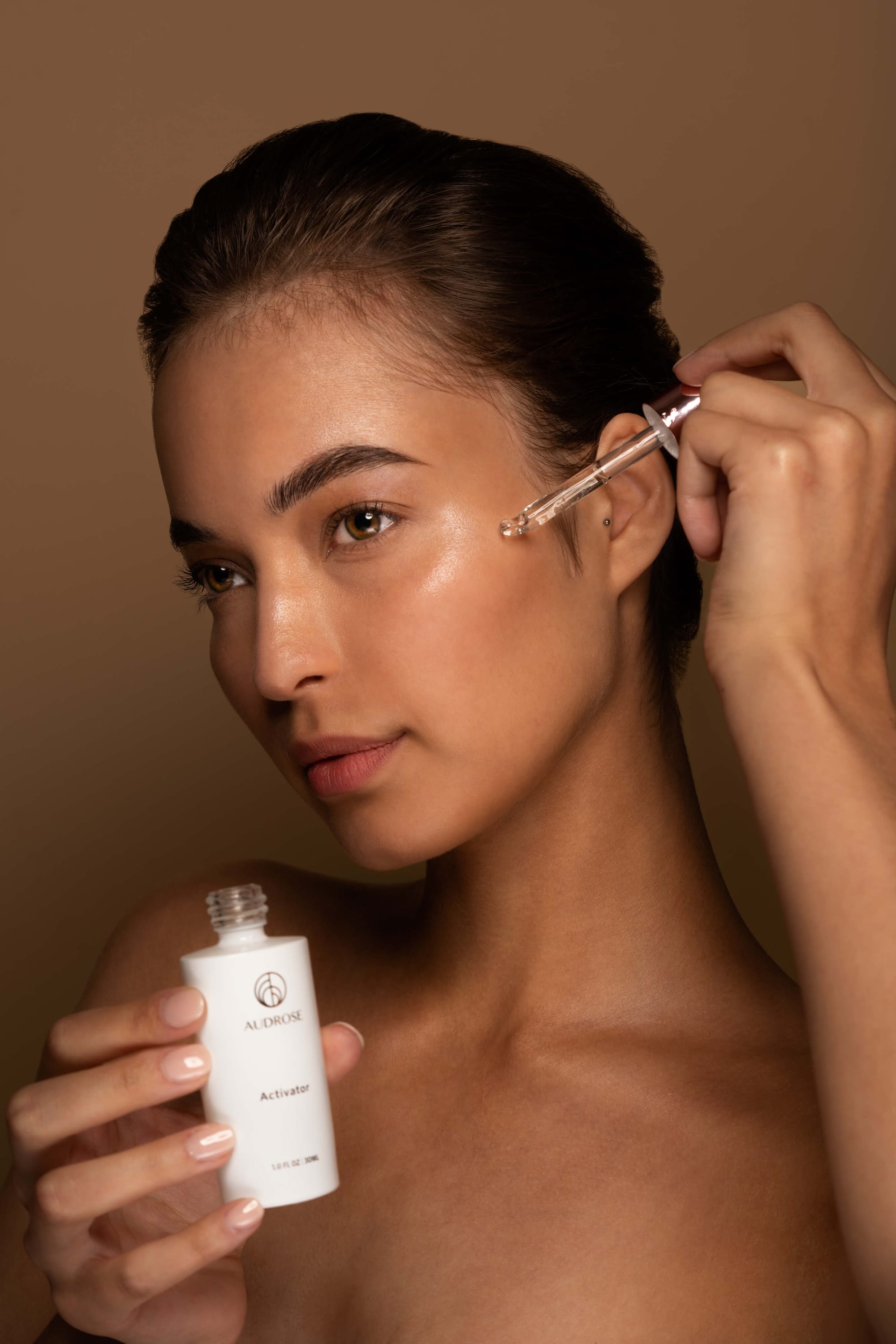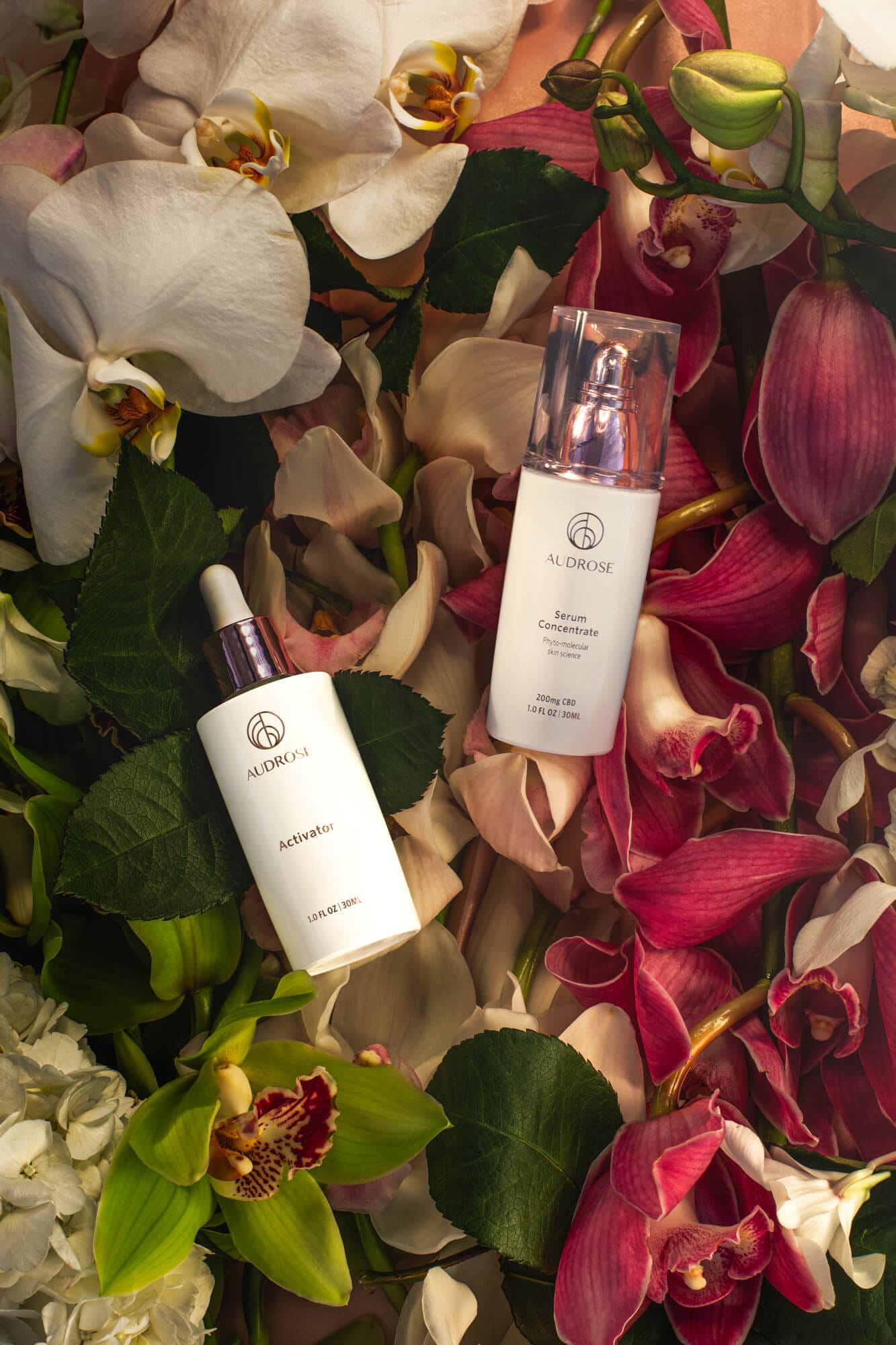
Justine Nichole, founder and CEO of Audrose Beauty, didn’t set out to build an international skincare and beauty brand. She just wanted a product that actually worked for her extremely sensitive skin.
After being diagnosed with ulcerative colitis at 21 during what was then her career as a cardiovascular nurse, she started various prescriptions to control her condition. The problem was that while they helped her auto-immune disease, they wreaked havoc on her skin.
“I remember working the night shift [at the hospital]. This sweet woman would open her clinic up and work on my face at 7 a.m. because I’d worked all night long on this 12-hour shift,” recalls Nichole. “I was so desperate to find relief for my skin and was so self-conscious.”
So began her journey to developing Audrose Beauty.
Arriving Where She Started
Nichole’s auto-immune disease gave rise to her years-long search for answers. She knew it was possible to have it all: a professional-grade skincare system designed for sensitive skin that offered an alternative to prescriptions and other prestige lines on the market.
She soon began meeting with chemists and scientists around the country, visiting labs and seeking the right active ingredients and botanicals that would calm her inflamed skin. But her worldwide search actually landed her at a lab in Texas, where she resided.
Working with an expert chemist, her team developed eight different formulas. The winner was the progenitor to Audrose’s Phyto-Molecular Skin Science™ — a top-secret formula so effective it has been patented in the U.S. with Canadian and EU patents underway. The formula isn’t just an active ingredient; it’s also a delivery system.
“It doesn’t just sit on your face. You can actually feel the absorption penetrate deep into the skin,” says Nichole. “And you can feel it that it locks in the benefits: the absorption, the hydration protection and calming effects for over 24 hours.”
After finding success with this formula, it was paired with another product (the activator) to form what Nichole calls the Audrose Protocol. The activator, which readies the skin, contains a primary active ingredient of orchid stem cells, which, as Nichole explained, communicate with human skin cells to prime them for the serum concentrate, which contains the Phyto-Molecular Skin Science™ in addition to six other potent, active anti-inflammatory ingredients.
Unsurprisingly considering her background, Nichole wanted consumers to use the product but also be assured that it was scientifically effective. So after the formulas for the Audrose activator and serum concentrate were set, she sought rigorous clinical testing of her product line.


Going Beyond 'Backed By Science'
A beauty brand claiming to be “backed by science” is often now considered a hoary cliche by the hyper-educated, eternally online consumer. Considering that cosmetics and skincare products are designed to be human-safe chemicals for use on the skin and body, in theory, all cosmetics could affix the term to a brand and call it square.
That’s why some savvy consumers are starting to call the bluff of major skincare and cosmetics manufacturers. In fact, as of this year, several major players in the cosmetics industry, including Sephora and L’Oreal, are being sued for misleading marketing claims about their products, according to reporting by Women’s Wear Daily.
In contrast, Nichole’s brand Audrose can confidently claim that it delivers “proven results” without fear of backlash, because of the several clinical trials its core skincare system has undergone.
Results were measured not only by participant feedback — a common metric in beauty studies — but also through use of a VISIA multi-point imaging system. VISIA skin analysis is a method of imaging often used in dermatologists’ offices and med spas that allows for the recording and measuring of surface and subsurface skin conditions of the face. Red channel views specifically allow the camera to capture “sub-surface melanin and vascular conditions” for all skin tones, according to VISIA’s website.
In a study performed over a 30- to 90-day period, participants used the two core products in the Audrose Protocol (the activator and the serum concentrate) each day. Researchers performed VISIA and red channel imaging before the participants used the products, at specific milestones throughout the trial and after the trial was over.
Dr. Ellen Turner, double board-certified dermatologist and lead researcher on this clinical trial, wrote: “My patients with the most sensitive skin saw proven results in as little as two weeks when using the Audrose activator and Audrose serum concentrate.”
For the 90-day study participants, Dr. Turner measured the effectiveness of the product by performing another round of imaging. The product maintained its efficacy at the three-month point.
“With my clinical background, believing in science, [I know] that it’s not good enough just to say, ‘Okay, we have something that is supposed to be good,’” says Nichole. “No, we have to take the step and prove it. We need that actually prove that what we’re doing matters and works.”
In a third-party Swiss study specifically targeting the Phyto-Molecular Skin Science™ compound, the researchers concluded that this formula contained “special wound healing properties and anti-inflammatory properties.” Nichole said that many providers of radiofrequency (RF) microneedling procedures now provide the Audrose Protocol as aftercare to their RF patients, as it speeds patient recovery time.
Additionally, while the brand can’t make medical claims about how the product has treated skin conditions, Nichole noted that there are positive anecdotal observations and customer reviews from Dr. Turner’s patients. Individuals with conditions ranging from rosacea to psoriasis, as well as individuals using Accutane and undergoing radiation, were finding success with the Audrose Protocol.
“Her facial psoriasis patients were waiting for their insurance to kick in on their biologics, the medications she’s prescribing them for their diagnosis, but in the meantime, she was sending them home on the Audrose Protocol,” says Nichole. “And by the time the insurance came back, she was finding a lot of these patients were saying, ‘You know what, the Audrose is actually taking care of my skin, so we’re not going to go on the biologics,’ which was incredible.”
Along with the clinical evidence and consumer studies to support Audrose’s claims, Nichole also points to consumer behavior as an indicator of efficacy.
“We have not had any returns from people saying they can’t tolerate the formula, which is amazing,” she says.


Do No Harm
Audrose Beauty’s commitment to caring also extends beyond the individual to the level of community.
For starters, the product is only packaged in glass bottles. While the components of the products are attractive, this choice goes beyond aesthetics; the aim is to protect the consumer and the environment alike. In a first-of-its-kind consumer study performed by the Plastic Soup Foundation, researchers found that 9 out of 10 cosmetics products sampled in the study contained microplastics.
When products containing microplastics are used by humans, there are two destinations where these particles can go: the water supply or the human body.
When microplastics enter the water supply, wastewater treatment plants are incapable of filtering them. That means the treated water returns to larger waterways, home to aquatic animals and used for future drinking water. Additionally, a wastewater facility’s runoff sludge is then used to fertilize agricultural products.
The other alternative to sloughing microplastics into the water supply is that they’re absorbed into the human body. The human immune system is incapable of processing microplastics, which can lead to hormone-disruption and disregulation and chronic inflammation.
Nichole wasn’t about to put her inflammation-fighting skincare line into packaging that could counteract what it was intended to accomplish. As she explained, it truly matters what formulas are contained in, especially for the 70% of people globally who report they have sensitive skin.
“We know now that we should not be eating food out of plastic because it’s soaked up through our food and ingested,” says Nichole. “So why are we going to do that with our skincare, where we’re literally putting it on the largest organ of our body every single day?”
Additionally, Audrose’s packaging seeks to mitigate the damage done to the environment by the larger cosmetics industry. According to reporting by The Guardian, the global cosmetics industry creates 120 billion units of packaging annually — and most of it is unrecyclable.
Knowing that the Audrose bottles would not contribute to that insurmountable level of pollution was a huge decision factor for Nichole, even though it was more expensive to package the product in glass.
“When you start a company, it kind of dawns on you like, ‘Oh, wow, if this really goes well, we’re going to be pumping out a lot of bottles into our environment. Where are they all going to end up?’” says Nichole. “So it was important to go with glass and also make it recyclable.”
Audrose’s components are recyclable if cleaned well and deposited into the correct receptacle. But even if the bottle is unable to be recycled for whatever reason, the packaging at least won’t contribute to any microplastics leeching into the groundwater from a landfill.
Additionally, all Audrose products are produced in factories 100% powered by solar energy. They’re also vegan and cruelty-free, as well as free from common allergens and chemicals like gluten, sulfates, paraben and paraffin. The botanicals and active ingredients within the formulas are also all harvested sustainably.
“It’s a daunting thing to think about. You are going to ultimately be putting a lot of stuff into the environment. What is your imprint going to be? What is your carbon footprint really going to be?” asks Nichole.
“Obviously, as we grow, we want to continue to explore how to best do that and balance it out with our environment. We’re definitely very conscientious of that.”
What's Next
The future looks bright for Nichole and her small and mighty team, with buzz regarding the brand growing. In 2021, she collaborated with Vogue in New York City on Audrose’s official launch event, which was covered by the magazine with top beauty editors in attendance. Not too long after, the brand received coverage in Harper’s Bazaar Brazil.
Currently, the brand is in the U.S., Canada and Europe, but hasn’t gained a prominent foothold in South America — yet. Nichole hopes to change that. She is also in the process of expanding past just the Audrose activator and serum concentrate, hoping to roll out a complete skincare line in the next few months.
At this point, Nichole has fully arrived to do the fulfilling work of combining her passions of science and caregiving into an art.
“I always felt like I was going to do something meaningful. I didn’t know what it was going to be,” says Nichole. “I definitely feel like I’ve hit my stride with Audrose, founding the company and going through this journey.”
Follow Audrose Beauty on Instagram, X (formerly Twitter) and Facebook, or visit the brand’s website at audrosebeauty.com.
The Audrose Protocol is available on Amazon and Audrose Beauty’s website, as well as selected dermatologists and med-spas nationwide. Contact your favorite skincare provider to see if it carries Audrose Beauty.

